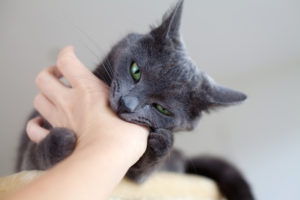When you go out shopping for a new toy or bedding for your cat, you’ll often try to find a color that vibes well with your cat. Whether you think the color suits them or if it fits in with their coat colors, the question is: does your cat know the difference? Can they even tell that there are a variety of colors?
From a young age, we might have been told that most animals can’t see color, but how true is that statement? While cats struggle to see certain hues and shades, they do see some things in color–just not everything.
Keep reading to learn more about cats and color blindness.
Color Perception in Cats
Color blindness does, in fact, affect our feline friends. To be color blind means that you are unable to discern certain colors from one another, especially in low light. It doesn’t always mean that you see in just black and white. Most people that are color blind have difficulty seeing reds and greens or blues and yellows.
With cats, it’s a bit more difficult to decipher what colors they can and cannot see simply because they cannot undergo a color-blind test the way humans can. Studies have been done to try to determine how cats see in comparison to human vision and what that means for their eyesight and ability to see different wavelengths of light.
Cat Vision Explained: How Do Cats See?
The eye has two specialized receptor cells in the retina. One type is called rod cells which aid in light vision. The other is cone cells, which are photoreceptors that aid in color vision.
People have three types of cones: one that allows us to see reds, one to see greens, and one to see blues. These three together help people see various colors in a range of shades and hues.
Cats were originally thought to have dichromatic vision, which means a cat’s cones help them see color, but they have a lower number of cones than humans — only two.
One is sensitive to blue-violet, and the other is sensitive to greens and yellows, leaving red out. One study found that cats had photopic trichromatic vision. This means that they see a similar range of colors as the human eye but with lower visual acuity; the colors are not as vibrant.
What Different Colors Can a Cat’s Eyes See?
There is much to debate about when it comes to what colors cats can see. If we say cats have photopic trichromatic, then it would be safe to say they can see all of the colors, but differently from how humans would. If we say that cats are dichromatic, then they can only see hues of purple, blue, green, and yellow.
Some people will think that their cat is unable to see certain colors based on how they react to toys or blankets. However, this is probably unlikely because of what colors they can and can’t see, and more so just about which objects your cat likes better.
What Colors Can’t Cats See?
Cats seem to show similarities to people with red-green color blindness. They also seem to be more sensitive to blues and yellows. This would mean that the main colors that cats likely have difficulty distinguishing are red, orange, and brown.
It’s possible that the way humans and cats see color is vastly different. Feline eyes are more likely to see in pastels than in vibrance, especially if we consider them to be photopic trichromatic.
How Do Cats Make Up For Color Blindness?
Cats rely on all of their senses to survive, but eyesight is still important. If your cat has more difficulty with their color vision, do not worry! They make up for it with their spectacular night vision and peripheral vision.
Night Vision
While they might not see as vibrant as humans, cats can see in the night better than us and need a lower amount of light to see clearly. They have more rods in the back of the eye than us, making their sensitivity to light more acute. The lack of color that they might experience is made up for by how well they can see in dim light.
Additionally, cats’ pupils can adjust in a range of light conditions. In the daytime, you might notice that their eyes look like thin slits. That’s because they don’t need to work hard to let any light in to see. In the dark, a cat’s pupils can dilate so that they are almost the same size as their eye, allowing for more light to come in and helping them see.
Wider Peripherals
Cats’ eyes are not as centered as humans, giving them a wider range of vision. This feature is to help them hunt and for other survival purposes. They can see at a 200 degrees angle, compared to a human’s 180 degrees, making it easier to spot predators and prey.
This does mean their depth perception isn’t as great as that of humans, but it is still considered very good in the animal kingdom.
Get All of Your Questions Answered with AskVet
No matter how long we have been a pet parent, there are new questions you’ll find yourself asking. You might find it helpful to be a part of a community of other pet parents looking for similar answers. When you sign-up with AskVet, you can gain access to this exact community.
Not only does AskVet provide you with answers when you schedule a virtual visit with our Certified Pet Lifestyle Coach™ (CPLC™), but you can join in with other pet parents in the AskVet Clubhouse to share stories and concerns you might have about your pet.
Sources:
Cat Color Vision: The Effect Of Stimulus Size, Shape And Viewing Distance | Science Direct
Neutral Point Testing Of Color Vision In The Domestic Cat | NCBI








